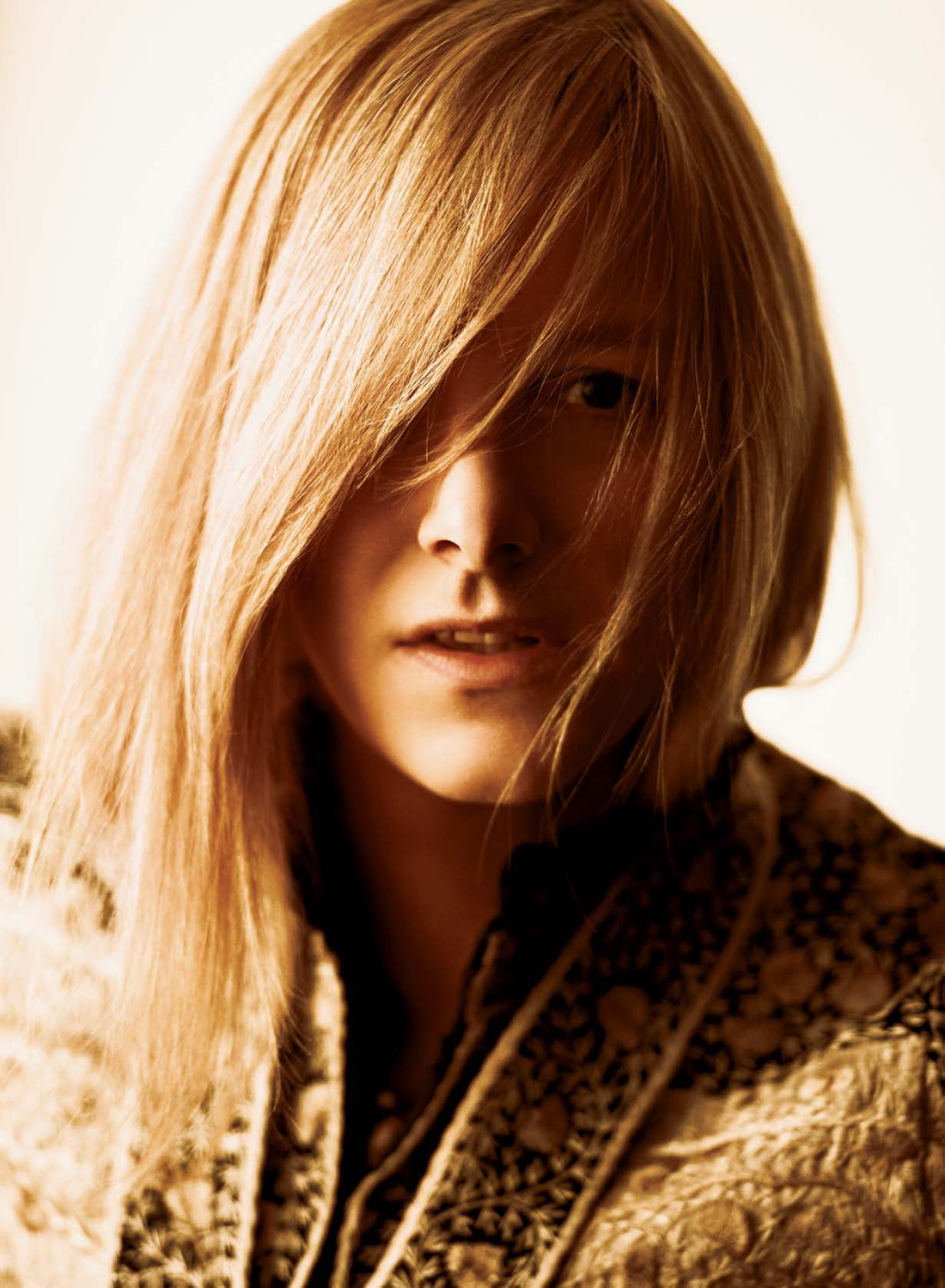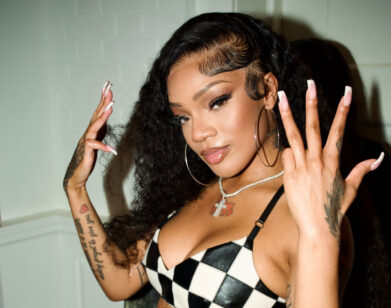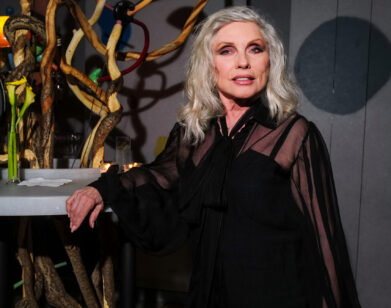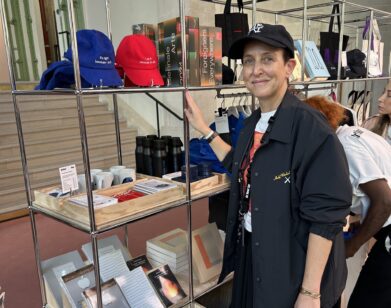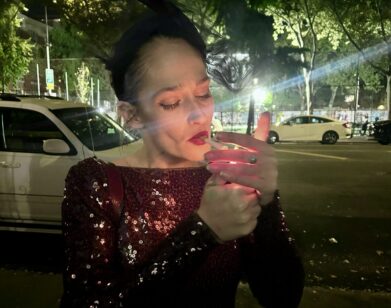Sarah Burton
THERE WILL ALWAYS BE A MCQUEEN WOMAN. SHE IS A STRONG WOMEN AND SHE IS A POWERFUL WOMAN, AND WHEN SHE PUTS A MCQUEEN JACKET ON, SHE FEELS DIFFERENTSarah Burton
When Sarah Burton was named Creative Director of Alexander McQueen in May 2010, she was charged with a task that many thought impossible. Just a few months earlier, her friend and mentor Lee McQueen had taken his own life at the age of 40, leaving Burton and others close to him to come to terms with the loss. It was Burton who, despite the circumstances, helped shepherd to completion McQueen’s last collection for Fall 2010, which was in progress when he died. And it was Burton who for years had worked alongside McQueen, first as an intern while she was still a student at Central Saint Martins and later as one of his chief collaborators, and was as familiar as anyone with the strict elegance and dark beauty that remained at the center of both his vision and the house’s DNA. So when parent company Gucci Group announced that the Alexander McQueen label would continue after its founder’s death and charged Burton with running the business, the announcement was greeted by many as an appropriate way to have the McQueen brand move forward while honoring its legacy. Burton, though, has made the decision look like a stroke of genius.
In many ways, the Manchester-raised Burton is the antithesis of a star designer, with a gentle warmth and humility that belie her considerable talent, knowledge, and technical skill. Nevertheless, her work so far at the helm of McQueen has drawn the spotlight to her. With curator Andrew Bolton, she helped pull together the blockbuster retrospective “Alexander McQueen: Savage Beauty” at the Metropolitan Museum of Art’s Costume Institute, which became one of the most-visited exhibitions in the museum’s 142-year history. She was inscribed into the history books after creating the elaborately embroidered gown that Catherine Middleton wore when she walked down the aisle with Prince William. But perhaps most importantly, Burton’s three critically acclaimed collections for McQueen have demonstrated her mastery of the extreme dress-up and tortured romanticism central to the house codes, as well as the formidable strength of her own voice as a designer, imbuing it all with a feminine lightness and a fragile vulnerability. In the process, she has not only allowed Alexander McQueen’s name to live on but also to remain at the center of the conversation in fashion in a way that her former boss—the consummate showman—would have loved.
For Spring 2012, Burton took things a step further, creating a collection of hyperfeminine lace and ruffled-chiffon dresses, but all with subversive touches— face-obscuring lace masks, black leather appliqué—that injected the clothes with some signature McQueen sharpness.
Sarah Jessica Parker recently connected with the 37-year-old Burton, who was at her London studio, to discuss her newly anointed status as the year’s brightest fashion star and what lies ahead, both for her and for the house of McQueen.
SARAH JESSICA PARKER: Rather than go back in time too much, I thought we could start with today and what you are doing right now. Where are you in the process of designing your next collection?
SARAH BURTON: I’ve literally just started on the next show today. We’re trying to find the right feeling and the right spirit for what to do, which is fun but also a bit daunting.
PARKER: For those of us who aren’t privy to these things, what is the process like? Do you all get together and someone says, “I’ve been thinking about lavender,” and you go around the room?
BURTON: It’s very organic. I sit with my team and we throw ideas around. I speak with Camilla Nickerson, the stylist I work with, and together we come up with who next season’s woman is and where she exists. Then we all just look at fabrics and prints and color. What’s great is that inspiration comes from every where; the process is fueled by lots of different things, and it changes all the time.
PARKER: And is it unique at your studio? Because one of the things that we’ve talked about in the past is that what distinguishes the McQueen line is that you develop your own prints, and not every designer has that opportunity. That’s something that was really important to Lee.
BURTON: Yeah, exactly. I think what’s amazing about McQueen and what was amazing about Lee was that he created this process where it was never really about fashion. It was always about a feeling and telling a story. And I think he sort of trained us all— trained me—to try to tell a story and to find a world that doesn’t necessarily relate to what everybody else is doing and to believe in your own instincts. And that went for everything. Lee really did believe in creating things that were unique to him and very special to the house. A lot of the prints and embroideries and jacquards are specifically designed not just for the collection, but for each garment.
PARKER: Who is the McQueen woman and where does she exist? Is she slightly different now for you? or does she change because the world changes?
BURTON: I think she does change because the world changes, but having worked for Lee for such a long time, his spirit is still very present. There’ll always be a McQueen woman. She is a strong woman and she is a powerful woman, and when she puts a McQueen jacket on, she feels different. the way she stands is different. The way she moves is different. It’s almost like the clothes are slightly empowering. There’s this emotion that goes into the clothes. and I try to keep it as true to . . . you know, Lee was such a genius that I can never pretend to be him, but I am very aware that I’m designing for a house that he created, and I try to keep it as true to that as possible.
PARKER: You were here for a long time, and so you can feel some confidence. I would guess that he would say, “Sarah, trust your instincts.”
BURTON: He would. Lee taught me that if you don’t believe in it, then you shouldn’t do it because you can’t stand behind it. He was brilliant because he would always say, “Things don’t stand still. It has to go forward,” or “Oh, don’t bring that old jacket out again. That’s been made before.” So I’m very conscious. I’ve got to move it because otherwise it stays still and it becomes stagnant.
PARKER: One of the stories that really stands out as a perfect example of what it was like when you first came to work for him is when he left you with a dress that was barely completed. He just said, “I’ll be back tomorrow,” and you were meant to finish it and you called your mother. Do you mind telling that story?
BURTON: I remember he pinned it on the stand, and it looked amazing. He had sort of half sewn it and he said, “Oh, I’m going out now. You can finish that.” and I remember thinking, I can’t possibly do that! I called my mum immediately. I was like, “Oh my god, well, how am I gonna finish this?” and she said, “Just get on with it.” What was so amazing about him is that he made you think that anything is possible. He made you challenge yourself all the time, which is why I loved working for him. Nothing was ever impossible. And that was amazing to be around. Completely inspiring.
PARKER: It’s also such a great way of teaching young people that they must seek their own identity, even within a house that’s established. Is that something you even need to talk about now with the people there, or is that just the culture of the place?
BURTON: I think it is the culture. We have quite a lot of interns and young designers who come for training, and I really feel that it’s important that they know how to patch and cut, that they know how to treat fabrics. What’s always been great about this place is that there’s not just one person who does jersey, one person who does denim. Everybody does everything and everyone knows the whole world that we’re working in. McQueen was so small, and Lee did everything: cut patterns, make clothes, everything. He was always so involved and hands-on. I was completely awed by what he was trying to achieve.
PARKER: You mention interns, and I know a little bit about how you first came to work with McQueen. Some people might be a little bit curious—or a lot curious—about the beginning.
BURTON: I went to a really academic school, but I always wanted to do fashion, and I was lucky enough to get in [to Central Saint Martins] and my tutor at the time, Simon Ungless, was one of Lee’s best friends, and he said, “Oh yeah, you should go and work for my friend Lee.” So I interned with Lee for a year, went back to college, and then came back. It was really lucky in many ways.
PARKER: What do you think your tutor saw in you? What were you like at that point in your life?
BURTON: It’s funny, because I sometimes ask that myself. I think maybe I was quite shy. I wasn’t the trendiest girl at college. I just loved what I was doing. I loved research at the time. I think I was always in the print room working.
WHAT WAS AMAZING ABOUT LEE WAS THAT HE CREATED THIS PROCESS WHERE IT WAS NEVER REALLY ABOUT FASHION. IT WAS ALWAYS ABOUT A FEELING AND TELLING A STORYSarah Burton
PARKER: Now that you’re in charge of the company, do you get to do the things that you used to do? Do you get to sit in front of a sewing machine? How different is it to run the whole business? That kind of responsibility can take you away from the creative side.
BURTON: If I’m honest, I had no idea of the size of the job. I had no idea of the other sorts of pressures that he must have faced. The great thing that Lee established is the ready-to-wear. It’s about the clothes. It’s not necessarily a bag- or shoe-driven company, it’s about this woman . . . In a funny way, I haven’t really stopped doing my old job.
PARKER: You are so clearly thriving in this position. It’s interesting to hear what is important to you and how you stay connected, creatively, while you also have to be a businessperson. It’s a bit like being the head of a ballet company who is required to do an enormous amount of fund-raising but is also the creative force and still has to be a really inspired, innovative thinker.
BURTON: Well, for me, it’s about people. I’m very lucky that I have an amazing team and this amazing place that Lee created where creativity is king. You could tell that when you saw the show at the Met.
PARKER: Do you want to talk a little bit about the Met exhibition and the process of putting that together? I know that it involved many McQueen people, like Trino Verkade [creative coordinator], Sam Gainsbury [show producer], Guido Palau [hairstylist], Judy Hall [pattern cutter] and Andrew Bolton at the Met and many others who might have been part of that conversation. What was that like for all of you—especially at that time?
BURTON: It was so raw in everybody’s minds. When we looked at the pieces, there was such sorrow. But it was also an amazing celebration of what Lee had done. It was really hard to pick the pieces that told the story of Lee because there were so many incredible ones.
PARKER: With limited space, you can’t put everything in. Were there any disagreements about which pieces to include?
BURTON: There was real agreement. Andrew did a selection from the archive, and then we would say, “Well, which piece was really important to Lee?” and maybe I said, “oh, Lee didn’t really like that piece.” Andrew did an amazing selection, and each of the rooms took you into another world. I mean, nobody knows what Lee wanted because Lee was so much his own person, but you sort of knew what he loved and what he did feel strongly for. I think that the rooms told a story but each of the garments had their own story and their own character and you could remember how they were made. Sometimes looking at them again, you couldn’t believe the pieces, and it was, like, “Oh my god, that’s amazing.” The number of people from different walks of life that I’ve talked to who went to see and who were really inspired by it. It was phenomenal.
PARKER: That genuine appreciation and curiosity about the art, the craftsmanship, and the storytelling— I don’t know if there’s ever been anything like that collective curiosity. So many different people who would say to me, “Did you see it?” and if I have the time-line correct, while you were preparing for the show, you also had a perfectly kept secret about a certain royal wedding dress that had to be made. What was that period like for you and the handful of people who knew and were working on Kate Middleton’s dress?
BURTON: Um, I mean . . . I’m not actually allowed to talk much about it at all. It was a precious, magical time that I’ll always treasure, and I feel like she gave me a gift in many ways. I feel incredibly privileged.
PARKER: Where does your inspiration come from? Do you see something when you’re driving home that you respond to? What happens when you get home at night? Do you listen to music?
BURTON: I do listen to music, but all kinds of music. I spend a lot of time at the studio. at home I have lots of books.
PARKER: Do you talk a lot about your work with your husband [photographer David Burton]? He shoots the campaigns, no?
BURTON: David Sims does the campaigns, but my David does the look book. He’s brilliant. He’s a very good listener. [laughs]
PARKER: I want to talk a little bit about the Spring 2012 collection. What was the inspiration? I think you’ve said “extreme beauty,” but what does that mean? Where did that come from?
BURTON: I think there is a romance to it, but it is slightly hard and more fetishistic. I think that we wanted to do something that was really about hyper-femininity. It was a difficult show as well, because the third show is always a tricky show. I had a sense that I wanted to make it very couture, very worked. Really about the way a woman is sort of an object of desire, but she’s an object of desire for herself, and the way that we adorn ourselves. The idea of heightened embellishment. And so we looked at all kinds of goddesses, and we kind of went to the sea and looked at the inside of shells and at colors that maybe could’ve been a little bit sickly. We used pinks and corals, and almost took it to an extreme of femininity, really.
PARKER: That’s so interesting that it’s as extreme as that—not so much the woman, but more the saturation of the color or the angle and how small her waist is and how what she’s wearing that’s extreme, in a way.
BURTON: Yeah. It was that exactly. It was almost like completely emphasizing everything about a woman, and Guido came up with this idea of embellishing the face as well, so it was almost as if the clothes were sort of growing on you. It wasn’t just about the model and the catwalk. The models almost become like this little army—an army of overly ornate women. No surface was untouched. Even for the chiffon ruffles, we sort of hand-massaged them. It’s not very good for production, but everything was tweaked and touched and embroidered and embellished.
PARKER: And at what point do you bring Guido in?
BURTON: Quite early on. I work really closely with Camilla Nickerson as well. She comes at the very beginning of the season. She works on the idea for who the woman is, and then I work with Sam along the way about what the show is going to be. And then Guido comes in and is amazing because he has an amazing vision of McQueen and of fashion in general. I’m very lucky to have these people to work with.
PARKER: Is expanding the contemporary McQ label part of the discussion with your team?
BURTON: Definitely. Because I feel that it’s very clear who the McQueen woman is, and I really feel that McQ has to have its own story to tell and its own woman. there’s no need to do a second line that is a poor-man’s version of the main line. It has to be different because there’s nothing worse than seeing a one-button jacket in a cheap fabric that’s an imitation of the main line. The pieces have got to be special in their own right.
PARKER: That’s kind of a different way of thinking. You want to give people something at a price point that still feels special. It doesn’t feel like, “Wow this is not great material, these aren’t great prints.” You want to give the McQ woman her own world.
BURTON: There is more of an ease to McQ. there is a world that is similar to the McQueen spirit and essence, but the pieces are not necessarily for a customer who buys the main line.
PARKER: Lee was very political. I always thought that there were wonderful subversive messages in the clothes. Sometimes they were more blatant, and other times they were quieter. I know that he had a lot of feelings about the world and class structure and the way people were treated and mistreated. Is the political something that’s in your brain, too, in some way?
BURTON: I really think that creating clothes and fashion has to be a statement about how we live and where we live and what’s happening in the world. So the reason the last show was very feminine and romantic was because I felt like the world wanted positivity and not darkness or gloom. I wanted it to feel very much about beauty, and I think that it related to Lee because it was very much about him. His collections were not just a statement on society, they were a complete statement on his beliefs, but they were also incredibly personal, often autobiographical. They were about what he was going through at the time, what he was feeling.
PARKER: And that can only happen with you if that’s authentically what’s on your mind.
PARKER: And how do you feel if somebody says, “It’s more feminine now that Sarah’s there.” Is that a fair characterization? Is it just something that happens because you’re a woman?
BURTON: You are obviously conscious that it has to be McQueen, but like you said, I am a woman. And there’s always been romance in McQueen and I think people sort of miss that it wasn’t wearable before, but there have always been great pieces to buy.
PARKER: I found his collections incredibly feminine, incredibly sexy, and I wonder if it wasn’t just that people just didn’t notice those qualities as much because he was a man, and with a woman designing them now, they seem more feminine. But I always thought he was very feminine and sentimental, in some ways. I always thought, “This is somebody who loves women.” When I put on a jacket and it fit so perfectly—
BURTON: Completely. I do think that Lee was incredibly romantic. There was always a quasi-Victorian way and a sort of dark romance, wasn’t there? You know, a love of the cycle of life—death, birth, love, marriage, all that. Lee was such a romantic in so many ways. I do think that Lee always surrounded himself with very strong women. How he cut for a woman, made for a woman, accentuated all of a woman’s shape—it was about the extreme accentuation of a woman’s shape. It’s always about strong women here.
PARKER: and it continues.
BURTON: Yeah. Definitely.
Sarah Jessica Parker is a Golden Globe-Nominated Actress.

